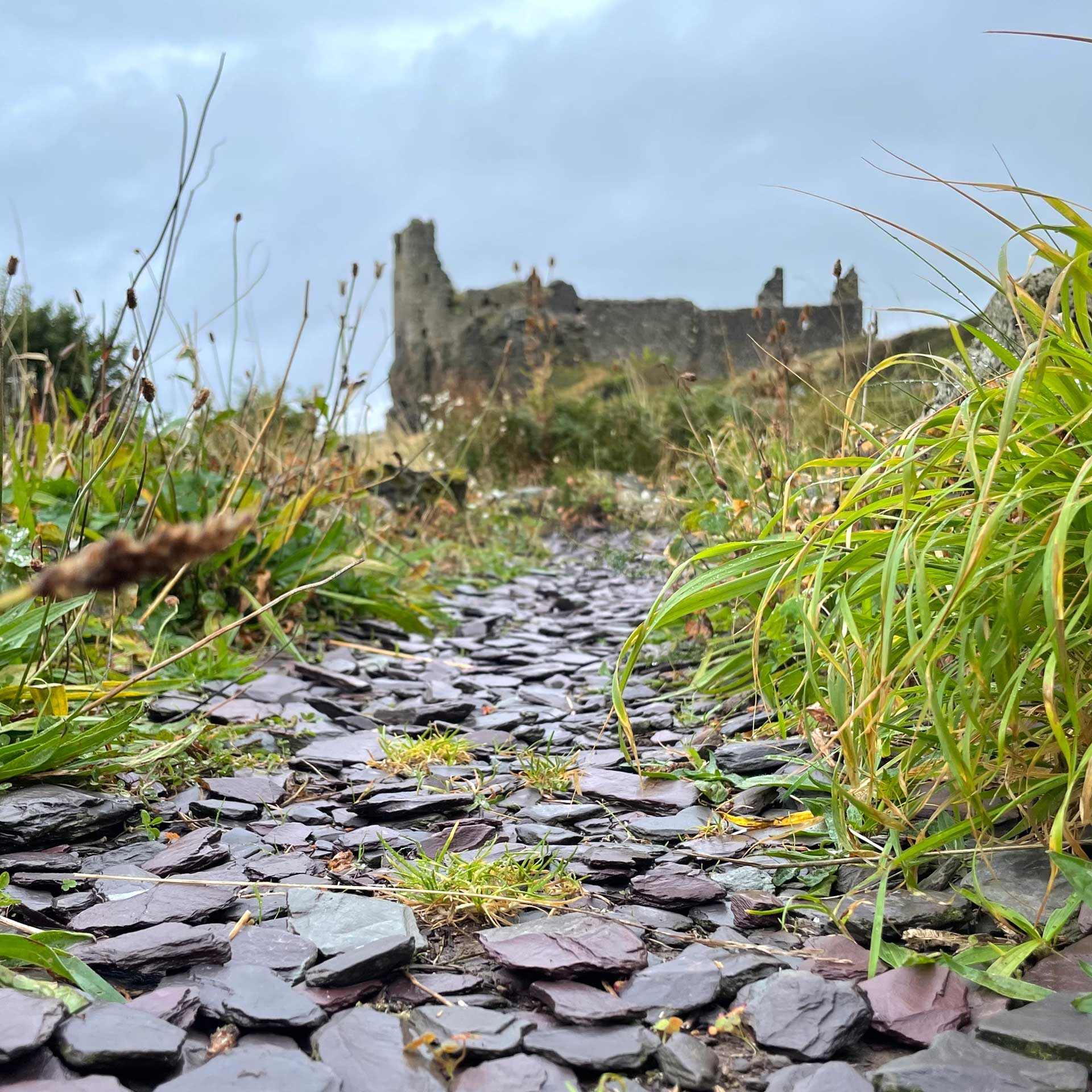Announcements
Upcoming organized events at the Dunure Labyrinth will be announced here.
There is nothing scheduled
Please check back in the future as we have regular updates to share.

Upcoming organized events at the Dunure Labyrinth will be announced here.
Please check back in the future as we have regular updates to share.
The Dunure Labyrinth is located in Kennedy Park in the village of Dunure, about 5 miles (8 km) south of Ayr.
From the carpark, there is a well-worn path to the castle (marked in white on the map below). To find the Labyrinth, you have to go the other direction, away from the castle path, towards a dip in the land. (First picture) While there is no visible path on the ground, the purple path on the map below shows where you will need to go.
You will walk past a BBQ/picnic area on the left (Second picture) and memorial benches on the right (Third picture).
The path to the labyrinth winds down to the right, with a handrail on the left (Fourth picture).
While there are plans in the works to improve the path to the labyrinth, the access is steep and currently a bit rough, so those with mobility issues may have difficulty reaching the labyrinth itself. In wet weather, the access may become more challenging, due to mud.
This should be taken into consideration if you are planning a visit, however, the spectacular view of the labyrinth against the castle ruin and the coastline can be appreciated from the memorial benches above.
While of ancient design, the Dunure Labyrinth is a relatively recent addition to the village.
Local Community Councillor Andy Guthrie spearheaded the project to construct the Dunure Labyrinth. His wife, Helen, first identified the current location looking from the ruins of Dunure Castle. At the time, the site was covered in growth, but beneath, it proved to be flat enough to provide an ideal location for the labyrinth.
In May 2008, the village was awarded £3,990 from Awards for All. The stones of the outline were donated from a well-known private local rock garden that was being dismantled. The slate for the paths was purchased for the project and requires regular maintenace with additional donated slate. The construction was implemented with the help of local residents, the British Trust for Conservation Volunteers, Community Service Volunteers, Dunure Community Council, and Fisherton primary school.
The village is very proud of their award-winning labyrinth. It has been awarded an ‘Action Earth’ award, and a biodiversity award from Scottish Natural Heritage. It has attracted international attention for its uniqueness and the captivating surroundings, especially among labyrinth enthusiasts. Pagans from around Scotland also feel a special connection to the labyrinth, Andy and Helen Guthrie being locally well-known Pagans.
Today, the labyrinth is maintained by volunteers from the village and local Pagan groups.
The labyrinth is a 50′ (approx. 15m) seven-circuit classical-style labyrinth.
Labyrinths are unicursal patterns, which means that there is one path in, and one path out, with no forced choices. This unicursal pattern makes them popular in contemporary contemplative practices. Their historical uses are not always clear, but it is an archetypal pattern that has existed for thousands of years.
The classical labyrinth pattern is the oldest surviving labyrinth design we have found. Exact dates are uncertain, but we can confidently say that it is at least 4,000 years old. It was the basis for most labyrinth designs that we know of until the Roman Era and continued to be used well beyond the introduction of different patterns. It remains one of the most popular labyrinth patterns for contemporary labyrinth construction.
“Seven-circuit” refers to the number of times the path winds around the centre. Labyrinths can be consrtuected with any odd-number of circuits, however, the earliest preserved labyrinths were seven-circuit and it remains the most popular configuration for the classical labyrinth.
There are many resources available for further information on the history and contemporary revival of labyrinths, including, most notably, Labyrinthos, The Labyrinth Society, and Veriditas.
Andy’s original design for the labyrinth included a series of trees to be planted along the perimeter, corresponding to the letters of the Proto-Irish/Old Irish ogham writing system. Derived from folklore and mediaeval sources, the tree correspondences were taken up by modern Pagans and expanded into a system of divination and calendar. The trees were planted, but the growing conditions were not favorable that year and most did not survive. Along the perimeter, there remain two wooden signs that Andy carved with the names of the ogham that correspond to the trees he planted. Luis, pictured below, is the second letter of the ogham alphabet and corresponds to the rowan, or mountain ash tree. Quert, also pictured, corresponds to the apple tree.
At the entrance of the Dunure Labyrinth is a crescent of crushed slate and stones, intended to represent a Pictish crescent and V-rod symbol. Historically, these symbols have been found on Pictish stones of class 1 (Pictish symbols only) and class 2 (Pictish and Christian symbols) as well as metal and bone objects. A few even turn up carved on the walls of caves. While the local area’s history is more Brythonic than Pictish, Andy’s choice to incorporate this symbol speaks to the broader connection of Scottish identity as a whole with the Pictish past.
If you would like to volunteer to help maintain the labyrinth, make a donation for the upkeep, or connect with others who love the Dunure Labyrinth, there is a Facebook group you can join called Dunure Labyrinth.
Kennedy Park, where the Dunure Labyrinth is situated, is owned by the South Ayrshire Council and administered by the Hall & Parks Committee of Dunure Community Council.
Enquiries about the Dunure Labyrinth can be made in the Facebook group or by email to [email protected]